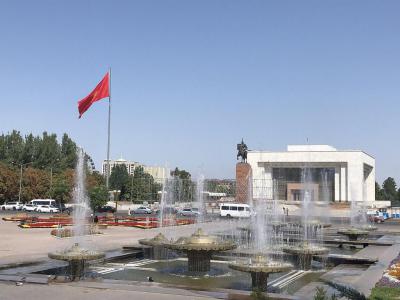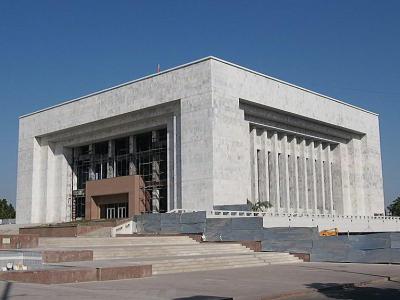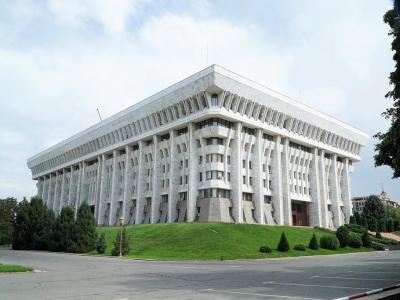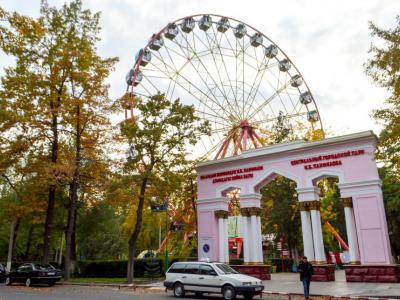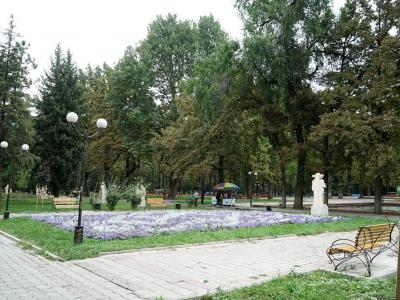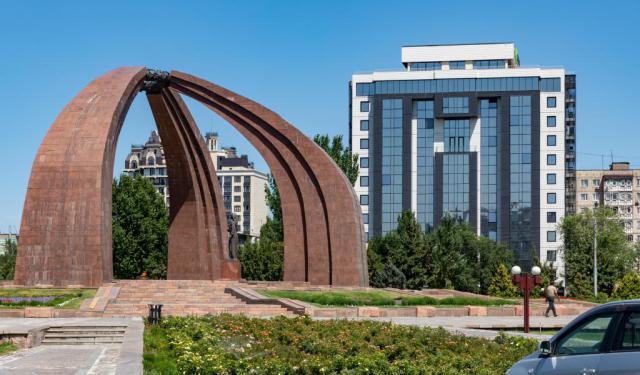
Bishkek Introduction Walking Tour (Self Guided), Bishkek
The capital city of Kyrgyzstan, Bishkek, is set against the picturesque backdrop of the snow-capped Tian Shan mountains at an altitude of 800 meters above sea level.
Compared to other major cities in Central Asia, Bishkek has a relatively short history. It was founded in 1825, as the Pishpek fortress, during the Russian colonization of the region. The fortress served as an administrative center and military outpost. In 1926, it was renamed Frunze after the Russian Bolshevik revolutionary, Mikhail Frunze, who was born in the city.
During the Soviet era, Frunze became an important industrial and cultural hub and served as the capital of the Kyrgyz Soviet Socialist Republic within the USSR. In 1991, following the collapse of the Soviet Union, the city's name was changed to Bishkek, derived from the Kyrgyz word for a paddle (or whorl) used for churning the fermenting mare's milk (known locally as “kumis”).
The legend has it that the pregnant wife of a local hero (“batyr”), one day, lost her domestic appliance. While looking for it, she suddenly gave birth to a baby boy, whom she named Bishkek. The boy would grow up to be a noble figure and, after his death, was buried on a mound near the banks of the Alamüdün River. The memorial earth dome (“gumbez”) erected on his gravesite was seen from far and away and described by travelers in the 17th-18th centuries.
Today's Bishkek abounds in spacious squares, wide boulevards with marble-faced buildings, and multiple monuments reflecting the country's past. Ala-Too, the central square in the heart of Bishkek, houses a large statue of Manas, a legendary hero of the Kyrgyz people. Located nearby is Oak Park, a pleasant green space known for its beautiful oak trees.
The National History Museum showcases exhibits on archaeology, traditional Kyrgyz lifestyle, arts, and the country's Soviet heritage. Victory Square, with a large Victory Monument in its center, commemorates the Soviet Union's victory in World War II.
These are just a few highlights of the city that continues to evolve as the vibrant capital of modern Kyrgyzstan. Whoever walks in its embrace, is bound to find Bishkek resembling a shimmering gem at the foot of Tien Shan, "adorned with the spirit of the Silk Road". Some say, the echoes of nomadic traditions still echo through the bustling cityscape of Bishkek. If you wish to hear them yourself, take this self-guided introductory walk and appreciate Bishkek in its variety.
Compared to other major cities in Central Asia, Bishkek has a relatively short history. It was founded in 1825, as the Pishpek fortress, during the Russian colonization of the region. The fortress served as an administrative center and military outpost. In 1926, it was renamed Frunze after the Russian Bolshevik revolutionary, Mikhail Frunze, who was born in the city.
During the Soviet era, Frunze became an important industrial and cultural hub and served as the capital of the Kyrgyz Soviet Socialist Republic within the USSR. In 1991, following the collapse of the Soviet Union, the city's name was changed to Bishkek, derived from the Kyrgyz word for a paddle (or whorl) used for churning the fermenting mare's milk (known locally as “kumis”).
The legend has it that the pregnant wife of a local hero (“batyr”), one day, lost her domestic appliance. While looking for it, she suddenly gave birth to a baby boy, whom she named Bishkek. The boy would grow up to be a noble figure and, after his death, was buried on a mound near the banks of the Alamüdün River. The memorial earth dome (“gumbez”) erected on his gravesite was seen from far and away and described by travelers in the 17th-18th centuries.
Today's Bishkek abounds in spacious squares, wide boulevards with marble-faced buildings, and multiple monuments reflecting the country's past. Ala-Too, the central square in the heart of Bishkek, houses a large statue of Manas, a legendary hero of the Kyrgyz people. Located nearby is Oak Park, a pleasant green space known for its beautiful oak trees.
The National History Museum showcases exhibits on archaeology, traditional Kyrgyz lifestyle, arts, and the country's Soviet heritage. Victory Square, with a large Victory Monument in its center, commemorates the Soviet Union's victory in World War II.
These are just a few highlights of the city that continues to evolve as the vibrant capital of modern Kyrgyzstan. Whoever walks in its embrace, is bound to find Bishkek resembling a shimmering gem at the foot of Tien Shan, "adorned with the spirit of the Silk Road". Some say, the echoes of nomadic traditions still echo through the bustling cityscape of Bishkek. If you wish to hear them yourself, take this self-guided introductory walk and appreciate Bishkek in its variety.
How it works: Download the app "GPSmyCity: Walks in 1K+ Cities" from Apple App Store or Google Play Store to your mobile phone or tablet. The app turns your mobile device into a personal tour guide and its built-in GPS navigation functions guide you from one tour stop to next. The app works offline, so no data plan is needed when traveling abroad.
Bishkek Introduction Walking Tour Map
Guide Name: Bishkek Introduction Walking Tour
Guide Location: Kyrgyzstan » Bishkek (See other walking tours in Bishkek)
Guide Type: Self-guided Walking Tour (Sightseeing)
# of Attractions: 8
Tour Duration: 2 Hour(s)
Travel Distance: 3.7 Km or 2.3 Miles
Author: Caroline
Sight(s) Featured in This Guide:
Guide Location: Kyrgyzstan » Bishkek (See other walking tours in Bishkek)
Guide Type: Self-guided Walking Tour (Sightseeing)
# of Attractions: 8
Tour Duration: 2 Hour(s)
Travel Distance: 3.7 Km or 2.3 Miles
Author: Caroline
Sight(s) Featured in This Guide:
- Ala-Too Square
- National History Museum
- White House
- Panfilov Park
- Oak Park and the Open Air Sculpture Museum
- Opera House
- Victory Square and Monument
- Chuy Avenue
1) Ala-Too Square (must see)
Ala-Too Square is a central square that holds great historical and cultural significance. Originally built in 1984 to commemorate the 60th anniversary of the Kirghiz Soviet Socialist Republic, the square was initially known as Lenin Square and featured a monumental statue of Lenin at its center.
However, with the independence of Kyrgyzstan from the USSR in 1991, the square underwent a transformation. In 2003, the statue of Lenin was relocated to a smaller square within the city, making way for a new statue called Erkindik, meaning "Freedom," symbolizing the nation's newfound independence. Subsequently, in 2011, the statue of Erkindik was replaced by a statue of Manas, a legendary hero from Kyrgyz folklore. This change was made to celebrate the 20th anniversary of Kyrgyzstan's independence, paying homage to its rich cultural heritage.
Ala-Too Square serves as a significant venue for various state events and celebrations, reflecting the country's historical milestones and achievements. The square has witnessed numerous gatherings, rallies, and memorial ceremonies, including a memorial ceremony in 2008 to honor the renowned Kyrgyz writer Chinghiz Aitmatov.
One of the notable events that took place at Ala-Too Square was the first Victory Day military parade in 2015, commemorating the 70th anniversary of the end of World War II. This momentous occasion was attended by the Prime Minister and served as a demonstration of national pride and remembrance.
Beyond its historical and ceremonial significance, Ala-Too Square also holds a symbolic place in the hearts of the people of Bishkek. It serves as a public gathering space and a central meeting point for locals and visitors alike. The square's open design, with its wide pathways and surrounding green spaces, invites people to stroll, relax, and enjoy the vibrant atmosphere of the city.
However, with the independence of Kyrgyzstan from the USSR in 1991, the square underwent a transformation. In 2003, the statue of Lenin was relocated to a smaller square within the city, making way for a new statue called Erkindik, meaning "Freedom," symbolizing the nation's newfound independence. Subsequently, in 2011, the statue of Erkindik was replaced by a statue of Manas, a legendary hero from Kyrgyz folklore. This change was made to celebrate the 20th anniversary of Kyrgyzstan's independence, paying homage to its rich cultural heritage.
Ala-Too Square serves as a significant venue for various state events and celebrations, reflecting the country's historical milestones and achievements. The square has witnessed numerous gatherings, rallies, and memorial ceremonies, including a memorial ceremony in 2008 to honor the renowned Kyrgyz writer Chinghiz Aitmatov.
One of the notable events that took place at Ala-Too Square was the first Victory Day military parade in 2015, commemorating the 70th anniversary of the end of World War II. This momentous occasion was attended by the Prime Minister and served as a demonstration of national pride and remembrance.
Beyond its historical and ceremonial significance, Ala-Too Square also holds a symbolic place in the hearts of the people of Bishkek. It serves as a public gathering space and a central meeting point for locals and visitors alike. The square's open design, with its wide pathways and surrounding green spaces, invites people to stroll, relax, and enjoy the vibrant atmosphere of the city.
2) National History Museum (must see)
The Kyrgyz State History Museum is a significant cultural institution that showcases the rich heritage of the Kyrgyz people. Established on December 9, 1925, it holds the distinction of being the first scientific institution in Kyrgyzstan and is renowned as one of the most important museums in Central Asia.
With its vast collection of artifacts spanning from antiquity to the end of the 20th century, the museum offers a comprehensive insight into the cultural history of the Kyrgyz people. Visitors can explore thousands of exhibits that encompass various aspects of Kyrgyzstan's heritage, including sculptures, objects, and artwork. The museum boasts a remarkable assortment of cave sculptures from the Bronze Age, ancient coin collections, and ethnographic objects such as jewelry and clothing from the 1st to the 5th century.
In addition to its archaeological and ethnographic displays, the museum also delves into the history of the Kyrgyz Soviet Socialist Republic. It houses a wealth of photographs and documents that provide a glimpse into the formation and development of the region during the Soviet era. Exhibits on the migration of people in Central Asia further deepen the understanding of Kyrgyzstan's historical context.
The museum offers visitors a chance to experience the traditional nomadic lifestyle of the Kyrgyz people. Within its premises, one can find a meticulously crafted nomad yurt, a portable dwelling made of felt, as well as mannequins adorned in traditional clothing, showcasing the vibrant cultural traditions of the Kyrgyz nomads.
Over time, the museum has undergone renovations and improvements. In 2016, supported by funding from the Turkish Cooperation and Coordination Agency, renovation work commenced on specific areas of the museum, ensuring the preservation and enhancement of its exhibits and facilities.
With its vast collection of artifacts spanning from antiquity to the end of the 20th century, the museum offers a comprehensive insight into the cultural history of the Kyrgyz people. Visitors can explore thousands of exhibits that encompass various aspects of Kyrgyzstan's heritage, including sculptures, objects, and artwork. The museum boasts a remarkable assortment of cave sculptures from the Bronze Age, ancient coin collections, and ethnographic objects such as jewelry and clothing from the 1st to the 5th century.
In addition to its archaeological and ethnographic displays, the museum also delves into the history of the Kyrgyz Soviet Socialist Republic. It houses a wealth of photographs and documents that provide a glimpse into the formation and development of the region during the Soviet era. Exhibits on the migration of people in Central Asia further deepen the understanding of Kyrgyzstan's historical context.
The museum offers visitors a chance to experience the traditional nomadic lifestyle of the Kyrgyz people. Within its premises, one can find a meticulously crafted nomad yurt, a portable dwelling made of felt, as well as mannequins adorned in traditional clothing, showcasing the vibrant cultural traditions of the Kyrgyz nomads.
Over time, the museum has undergone renovations and improvements. In 2016, supported by funding from the Turkish Cooperation and Coordination Agency, renovation work commenced on specific areas of the museum, ensuring the preservation and enhancement of its exhibits and facilities.
3) White House
The White House in Bishkek serves as the presidential office building and holds significant historical importance. It has been the backdrop for pivotal events in the country's recent history, including the 2005 Tulip Revolution and the 2010 Kyrgyzstani riots.
Located on Chuy Avenue, between the Philharmonia building and the Monument to the Martyrs of the Revolution, the White House is a seven-story structure constructed in the Stalinist modern architectural style. It was designed with the STO (Gosplan, Duma) building in Moscow as a model. Originally built in 1985, the building was intended to house the headquarters of the Communist Party's Central Committee.
The White House gained notoriety during the 2005 Tulip Revolution, when large-scale protests erupted in response to allegations of electoral fraud. Demonstrators rallied outside the building, demanding political change and the resignation of the incumbent president. Subsequently, in 2010, the White House became the center of attention once again during the Kyrgyzstani riots, characterized by widespread unrest and clashes between different ethnic groups. Tragically, during the 2010 riots, a fire broke out within the White House, resulting in significant damage to the building and the destruction of numerous government records stored in hard copy format.
Interestingly, there are rumors of an underground complex beneath Ala-Too Square, purportedly connected to the White House via a network of underground tunnels. While the existence and purpose of this underground structure remain speculative, it adds an air of mystery and intrigue to the White House's history.
Located on Chuy Avenue, between the Philharmonia building and the Monument to the Martyrs of the Revolution, the White House is a seven-story structure constructed in the Stalinist modern architectural style. It was designed with the STO (Gosplan, Duma) building in Moscow as a model. Originally built in 1985, the building was intended to house the headquarters of the Communist Party's Central Committee.
The White House gained notoriety during the 2005 Tulip Revolution, when large-scale protests erupted in response to allegations of electoral fraud. Demonstrators rallied outside the building, demanding political change and the resignation of the incumbent president. Subsequently, in 2010, the White House became the center of attention once again during the Kyrgyzstani riots, characterized by widespread unrest and clashes between different ethnic groups. Tragically, during the 2010 riots, a fire broke out within the White House, resulting in significant damage to the building and the destruction of numerous government records stored in hard copy format.
Interestingly, there are rumors of an underground complex beneath Ala-Too Square, purportedly connected to the White House via a network of underground tunnels. While the existence and purpose of this underground structure remain speculative, it adds an air of mystery and intrigue to the White House's history.
4) Panfilov Park (must see)
Panfilov Park is a city memorial that holds historical significance. The park is named after Ivan Panfilov, a Hero of the Soviet Union and the chairman of the Military Committee of the Kirghiz SSR.
The park was originally established in 1924 and was known as Zvezda Park, designed in the shape of a star. In 1942, it was renamed in honor of Ivan Panfilov. That same year, the park underwent reconstruction to accommodate the Panfilov IV monument. This monument, unveiled in 1944, was the first of its kind in the Soviet Union dedicated to commemorating Panfilov's service.
Panfilov Park serves as a place of remembrance and tribute to Ivan Panfilov and the 28 soldiers of the 316th Rifle Division who heroically fought against German invaders during World War II. The park features the monument of Ivan Panfilov, standing as a symbol of courage and sacrifice. The monument stands as a reminder of the brave deeds of these soldiers and their contributions to the defense of their homeland.
Throughout the years, Panfilov Park has been the site of various commemorative events and ceremonies. Notably, on the 80th anniversary of the 8th Guards Motor Rifle Division in 2021, Kyrgyz servicemen from the division marched to Panfilov Park to participate in an anniversary ceremony, paying tribute to the division's history and achievements.
The park was originally established in 1924 and was known as Zvezda Park, designed in the shape of a star. In 1942, it was renamed in honor of Ivan Panfilov. That same year, the park underwent reconstruction to accommodate the Panfilov IV monument. This monument, unveiled in 1944, was the first of its kind in the Soviet Union dedicated to commemorating Panfilov's service.
Panfilov Park serves as a place of remembrance and tribute to Ivan Panfilov and the 28 soldiers of the 316th Rifle Division who heroically fought against German invaders during World War II. The park features the monument of Ivan Panfilov, standing as a symbol of courage and sacrifice. The monument stands as a reminder of the brave deeds of these soldiers and their contributions to the defense of their homeland.
Throughout the years, Panfilov Park has been the site of various commemorative events and ceremonies. Notably, on the 80th anniversary of the 8th Guards Motor Rifle Division in 2021, Kyrgyz servicemen from the division marched to Panfilov Park to participate in an anniversary ceremony, paying tribute to the division's history and achievements.
5) Oak Park and the Open Air Sculpture Museum
Oak Park is home to the captivating Open Air Sculpture Museum. This unique museum showcases 90 remarkable sculptures that adorn the green pathways of the park, creating a harmonious blend of art and nature.
Established in 1984 as part of the All Union Sculptors Symposium, which coincided with the 60th anniversary of Kyrgyzstan's accession to the Soviet Union, the Open Air Sculpture Museum attracts visitors with its diverse collection. During the symposium, artists and sculptors from across the Soviet Union gathered in Bishkek to display their works in Oak Park under the theme of "Work and Peace."
Walking through the paths of Oak Park and admiring the sculptures is a delightful experience that takes approximately 30 minutes. While some of the sculptures show signs of degradation due to their exposure to the elements over the years, many have remarkably withstood the test of time.
One standout sculpture is "Mother and Child" (1985) by V. Hegun. Depicting a mother cradling a young child in her lap, this nearly four-decade-old artwork reflects the modern life of Bishkek, where a high birth rate contributes to a bustling city filled with children and the loving figures of their mothers and grandmothers.
Another whimsical sculpture that catches the eye is "Fossilized Rhino" (1985) by V. Friu. This sculpture features the head of a rhinoceros mounted on a pedestal with body-like contours, adding a touch of intrigue and playfulness to the museum.
Be sure to keep an eye out for "Legend" (1986) by J. Rustamov, which portrays a woman delicately feeding a doe from her hand. Despite its exposure to the elements, this intricate sculpture has aged gracefully, showcasing the artist's skill and attention to detail. There is also an unnamed wooden sculpture, likely more recent, depicting an eagle perched atop a stump. This piece highlights the proud tradition of falconry in Kyrgyz culture.
The museum offers a serene atmosphere, surrounded by oak trees that provide shade and protection. Open 24/7, Oak Park attracts both tourists and locals seeking peace and inspiration. While it can be busier in the evenings, mornings tend to be quieter, allowing visitors to fully immerse themselves in the art and surroundings.
Most sculptures in the museum are accompanied by steel plaques that display the name of the artwork and the artist. However, there are a few sculptures without labels, adding an element of mystery and discovery to the experience.
Established in 1984 as part of the All Union Sculptors Symposium, which coincided with the 60th anniversary of Kyrgyzstan's accession to the Soviet Union, the Open Air Sculpture Museum attracts visitors with its diverse collection. During the symposium, artists and sculptors from across the Soviet Union gathered in Bishkek to display their works in Oak Park under the theme of "Work and Peace."
Walking through the paths of Oak Park and admiring the sculptures is a delightful experience that takes approximately 30 minutes. While some of the sculptures show signs of degradation due to their exposure to the elements over the years, many have remarkably withstood the test of time.
One standout sculpture is "Mother and Child" (1985) by V. Hegun. Depicting a mother cradling a young child in her lap, this nearly four-decade-old artwork reflects the modern life of Bishkek, where a high birth rate contributes to a bustling city filled with children and the loving figures of their mothers and grandmothers.
Another whimsical sculpture that catches the eye is "Fossilized Rhino" (1985) by V. Friu. This sculpture features the head of a rhinoceros mounted on a pedestal with body-like contours, adding a touch of intrigue and playfulness to the museum.
Be sure to keep an eye out for "Legend" (1986) by J. Rustamov, which portrays a woman delicately feeding a doe from her hand. Despite its exposure to the elements, this intricate sculpture has aged gracefully, showcasing the artist's skill and attention to detail. There is also an unnamed wooden sculpture, likely more recent, depicting an eagle perched atop a stump. This piece highlights the proud tradition of falconry in Kyrgyz culture.
The museum offers a serene atmosphere, surrounded by oak trees that provide shade and protection. Open 24/7, Oak Park attracts both tourists and locals seeking peace and inspiration. While it can be busier in the evenings, mornings tend to be quieter, allowing visitors to fully immerse themselves in the art and surroundings.
Most sculptures in the museum are accompanied by steel plaques that display the name of the artwork and the artist. However, there are a few sculptures without labels, adding an element of mystery and discovery to the experience.
6) Opera House
The Kyrgyz State Opera and Ballet Theater holds a significant place in the country's cultural landscape. Founded on November 7, 1930, it was the first European-style theatrical institution in Kyrgyzstan, formerly known as Frunze. The theater played an essential role in promoting opera and ballet in the region.
During the Soviet era, opera houses and ballet theaters were established in major cities across all fifteen Soviet Republics, and the Kyrgyz State Theater became a prominent venue for artistic performances. On August 17, 1942, the theater was renamed the V.I. Lenin Kyrgyz State Opera and Ballet Theater, paying tribute to Vladimir Lenin. In 1955, the theater found its permanent home on Abdrahmanov St in Bishkek's city center.
The impressive building, designed by architect L. Laburenko with participation from P. Ivanov, stands out with its grand Greek-style columns, bas reliefs depicting the muses, and the Soviet hammer and sickle emblem. This unique architectural style diverged from the traditional Soviet designs.
In 1959, the theater was granted the prestigious title of Academic, recognizing its excellence in performing arts. In 1978, it was officially renamed the Kyrgyz State Order of V.I. Lenin Academic Opera and Ballet Theater, honoring Kyrgyz composer Abdylas Maldybayev.
Throughout its history, the theater has produced numerous operas and ballets, many of which have become iconic classics. During the Soviet era, it staged famous works like Swan Lake, Eugene Onegin, La Traviata, Don Carlos, Prince Igor, La Boheme, Faust, and the Queen of Spades. Even after the collapse of the Soviet Union, the theater continued to showcase these beloved productions, maintaining their popularity among audiences.
During the Soviet era, opera houses and ballet theaters were established in major cities across all fifteen Soviet Republics, and the Kyrgyz State Theater became a prominent venue for artistic performances. On August 17, 1942, the theater was renamed the V.I. Lenin Kyrgyz State Opera and Ballet Theater, paying tribute to Vladimir Lenin. In 1955, the theater found its permanent home on Abdrahmanov St in Bishkek's city center.
The impressive building, designed by architect L. Laburenko with participation from P. Ivanov, stands out with its grand Greek-style columns, bas reliefs depicting the muses, and the Soviet hammer and sickle emblem. This unique architectural style diverged from the traditional Soviet designs.
In 1959, the theater was granted the prestigious title of Academic, recognizing its excellence in performing arts. In 1978, it was officially renamed the Kyrgyz State Order of V.I. Lenin Academic Opera and Ballet Theater, honoring Kyrgyz composer Abdylas Maldybayev.
Throughout its history, the theater has produced numerous operas and ballets, many of which have become iconic classics. During the Soviet era, it staged famous works like Swan Lake, Eugene Onegin, La Traviata, Don Carlos, Prince Igor, La Boheme, Faust, and the Queen of Spades. Even after the collapse of the Soviet Union, the theater continued to showcase these beloved productions, maintaining their popularity among audiences.
7) Victory Square and Monument
Victory Square is a significant public square dedicated to commemorating the victory over Nazi Germany in World War II. Established in 1985, the square was created to mark the 40th anniversary of the end of the war, serving as a testament to the courage and sacrifice of the Allied forces.
At the heart of Victory Square stands the Victory Monument, a powerful memorial dedicated to the victory achieved by the Allies. The monument depicts a woman, symbolizing the mothers and wives who anxiously awaited the return of their sons and husbands from the war. It serves as a poignant reminder of the immense human toll of the conflict. Adorned with national symbols such as the Kyrgyz yurt, the monument is a breathtaking sight, invoking a sense of reverence and gratitude.
Another notable feature of Victory Square is the eternal flame, a solemn tribute to the fallen soldiers. The flame is guarded by a detachment from the National Guard of Kyrgyzstan, with a changing of the guard ceremony occurring hourly. The eternal flame represents the everlasting memory of those who gave their lives in the pursuit of victory and serves as a place for contemplation and remembrance.
Victory Square holds great significance for the nation, and it serves as a focal point for official ceremonies and parades. Each year on Victory Day, celebrated on May 9th, grand parades take place on the square, featuring personnel from the Armed Forces of Kyrgyzstan, the Ministry of the Interior, and the Emergencies Ministry. These events honor the bravery and resilience of the veterans and pay tribute to the historical significance of the victory over Nazi Germany.
At the heart of Victory Square stands the Victory Monument, a powerful memorial dedicated to the victory achieved by the Allies. The monument depicts a woman, symbolizing the mothers and wives who anxiously awaited the return of their sons and husbands from the war. It serves as a poignant reminder of the immense human toll of the conflict. Adorned with national symbols such as the Kyrgyz yurt, the monument is a breathtaking sight, invoking a sense of reverence and gratitude.
Another notable feature of Victory Square is the eternal flame, a solemn tribute to the fallen soldiers. The flame is guarded by a detachment from the National Guard of Kyrgyzstan, with a changing of the guard ceremony occurring hourly. The eternal flame represents the everlasting memory of those who gave their lives in the pursuit of victory and serves as a place for contemplation and remembrance.
Victory Square holds great significance for the nation, and it serves as a focal point for official ceremonies and parades. Each year on Victory Day, celebrated on May 9th, grand parades take place on the square, featuring personnel from the Armed Forces of Kyrgyzstan, the Ministry of the Interior, and the Emergencies Ministry. These events honor the bravery and resilience of the veterans and pay tribute to the historical significance of the victory over Nazi Germany.
8) Chuy Avenue
Chuy Avenue, locally known as Chüy Prospekti is a significant thoroughfare that stretches from the eastern border of the city to Deng Xiaoping Prospekti in the west. Throughout its history, Chuy Avenue has undergone several name changes, reflecting the country's shifting political and social landscape.
Originally known as Kupecheskaya (Merchant) Street, the avenue was renamed Grazhdanskaya (Civil) Street in 1924. It further evolved to Stalin Street in 1936, XXII Parts'ezd Street in 1961, and finally became Lenin Prospekt in 1974. Each renaming represented the ideological and political transformations that Kyrgyzstan experienced during the 20th century.
Prior to the October Revolution, Chuy Avenue was lined with various significant structures, including the Serafim Church, Tatar Mosque with a medrese (Islamic school), as well as small shops owned by merchants. The street was characterized by a mix of timber houses and clay-walled huts. Unfortunately, over time, these historical buildings and landmarks ceased to exist.
In the 1920s, the Serafim Church was repurposed into a social club, while the mosque and medrese were transformed into a school. However, none of these structures have survived to the present day, leaving behind the memories and traces of a bygone era.
Today, Chuy Avenue stands as a bustling and vital artery in Bishkek, reflecting the modern urban landscape of the city. It serves as a central hub for various activities, with numerous commercial establishments, government offices, cultural institutions, and residential areas dotting its length. As one of the major avenues in the city, Chuy Avenue plays a crucial role in the daily lives of residents and visitors alike, connecting different parts of Bishkek and contributing to the vibrant atmosphere of the capital of Kyrgyzstan.
Originally known as Kupecheskaya (Merchant) Street, the avenue was renamed Grazhdanskaya (Civil) Street in 1924. It further evolved to Stalin Street in 1936, XXII Parts'ezd Street in 1961, and finally became Lenin Prospekt in 1974. Each renaming represented the ideological and political transformations that Kyrgyzstan experienced during the 20th century.
Prior to the October Revolution, Chuy Avenue was lined with various significant structures, including the Serafim Church, Tatar Mosque with a medrese (Islamic school), as well as small shops owned by merchants. The street was characterized by a mix of timber houses and clay-walled huts. Unfortunately, over time, these historical buildings and landmarks ceased to exist.
In the 1920s, the Serafim Church was repurposed into a social club, while the mosque and medrese were transformed into a school. However, none of these structures have survived to the present day, leaving behind the memories and traces of a bygone era.
Today, Chuy Avenue stands as a bustling and vital artery in Bishkek, reflecting the modern urban landscape of the city. It serves as a central hub for various activities, with numerous commercial establishments, government offices, cultural institutions, and residential areas dotting its length. As one of the major avenues in the city, Chuy Avenue plays a crucial role in the daily lives of residents and visitors alike, connecting different parts of Bishkek and contributing to the vibrant atmosphere of the capital of Kyrgyzstan.
Walking Tours in Bishkek, Kyrgyzstan
Create Your Own Walk in Bishkek
Creating your own self-guided walk in Bishkek is easy and fun. Choose the city attractions that you want to see and a walk route map will be created just for you. You can even set your hotel as the start point of the walk.
Soviet Era Architecture and Monuments Tour
While nomadic communities of yurt-living, horse-riding sheep herders are still thriving in the most remote valleys of Kyrgyzstan, the capital city of Bishkek shows a different facet of this Central Asian nation.
Built practically from scratch during the Soviet era, Bishkek experienced significant transformation in terms of urban planning and is packed to the rim with a well-preserved... view more
Tour Duration: 2 Hour(s)
Travel Distance: 3.6 Km or 2.2 Miles
Built practically from scratch during the Soviet era, Bishkek experienced significant transformation in terms of urban planning and is packed to the rim with a well-preserved... view more
Tour Duration: 2 Hour(s)
Travel Distance: 3.6 Km or 2.2 Miles
The Most Popular Cities
/ view all
